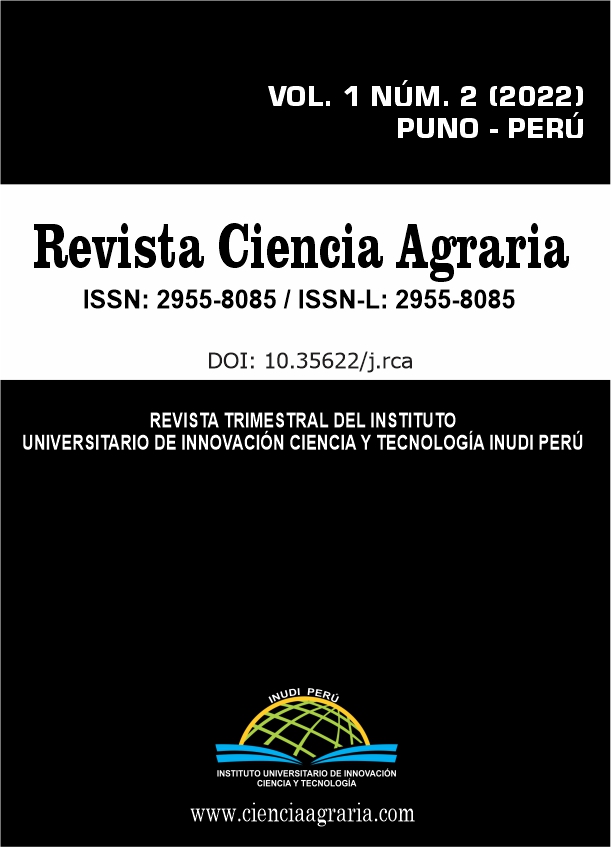Fluoride removal in drinking water by precipitation-flocculation with aluminum polychloride and lime milk
DOI:
https://doi.org/10.35622/j.rca.2022.02.001Keywords:
fluoride, polyaluminum, chloride, lime, coagulation, flocculationAbstract
The study consisted of evaluating the percentage of fluoride removal from drinking water by precipitation and flocculation with aluminum polychloride and lime milk. The research includes the treatment of well water from the highlands which was carried out at the laboratory level in order to remove fluoride from drinking water. According to the monitoring carried out, the water from the Taraco well contains 2.23 mg/L of F and the water from the Juli well contains 2.20 mg/L of F. The results of the fluoride removal process with poly aluminum chloride were 56 %, with a reduction from 2.23 mg/L F to 0.98 mg/L F. During the flocculation process, the pH, time and stirring speed were controlled. The removal of fluoride with milk of lime has been reduced from 2.23 mg/L of F to 1.5 mg/L of F. The experimental tests of precipitation and flocculation were carried out in the quality control laboratory of the Faculty of Chemical Engineering. The equipment used is Test Jar and pH meter. Regarding the statistical method, the 2' factorial design has been used, which has allowed optimization of the parameters of the flocculation process.
References
Bischop, P. & Sansoucy, G. (1979). Fluoride removal from drinking water by fluidized activated alumina adsoption. J Am. Water Works: 70(10): 254-259. DOI: https://doi.org/10.1002/j.1551-8833.1978.tb04242.x
Choi, W. & Chen, K. (1979). The removal of fluoride water by adsoption. Water Tech: 71(10): 562-570. DOI: https://doi.org/10.1002/j.1551-8833.1979.tb04420.x
Cochran, W. G., Cox, G. M. (1997). Diseños experimentales, Trillas, 2da edición, México.
Kaseva M. (2006). Optimization of regenerated bon char for fluoride removal in drinking wáter: a case study in Tanzania. Journal of Water and Health: 4(1): 139-147. DOI: https://doi.org/10.2166/wh.2006.0011
Link W.E and Rabosky J. G. (1977). Fluoride ion removal from waste water Employing calcium precipitation and iron salt coagulation. Proceedings of the Industrial Waste Conference Volume Date 1976, Murdoch/Betz Eng., Inc., Pittsburgh, PA. USA.
Medellin-Castillo, N.A., Leyva-Ramos, R., Ocampo-Perez, R., Garcia de la Cruz, R.F., Aragon-Pina, A., Martínez-Rosales, J.M., Guerrero-Coronado, R.M., Fuentes-Rubio, L.: Adsorption of fluoride from water solution on bone char. Ind. Eng. Chem. Res. 46, 9205–9212 (2007) DOI: https://doi.org/10.1021/ie070023n
Mohapatra D., Mishra D. Mishra S,P. (2004). Use of oxide minerals to abate fluoride from water. J of C. and Int. Sc: 275, 355-359. DOI: https://doi.org/10.1016/j.jcis.2004.02.051
Mjengera H. (2000). Defluoridation of drinking water in Tanzania. Technical Annual Report. WARFSA Swedish International Development Agency: 1-25.
Saha H. (1993). Treatment of aqueous effluent for fluoride removal. Water Research. DOI: https://doi.org/10.1016/0043-1354(93)90222-4
Valenzuela V. L. Ramirez H. J. Reyes L. J. Sol U.J. A., Lázaro M. 0. (2006). The origin of fluoride in groundwater supply to Hermosillo city, Sonora. Environmental Geology: 51(1): 17-27. DOI: https://doi.org/10.1007/s00254-006-0300-7
Van-Benschoten, J. & Edzwald, J. (1990). Chemical aspects of coagulation using aluminum salts—I. Hydrolytic reactions of alum and polyaluminum chloride. Water Research 24 (12), 1519-1526. DOI: https://doi.org/10.1016/0043-1354(90)90086-L
Published
Issue
Section
License
Copyright (c) 2022 Ornela Pancca, Gregorio Palomino

This work is licensed under a Creative Commons Attribution 4.0 International License.











